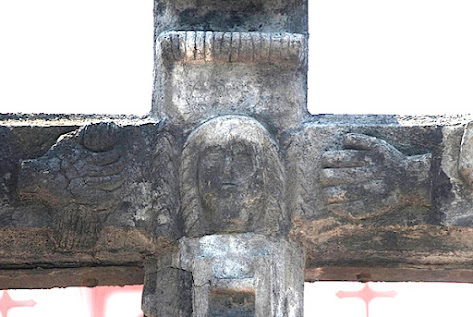This dismal outlying barrio, just north east of Tultitlan, in northern Mexico City nevertheless boasts a pretty church dedicated to Saints Peter and Paul. It is also home to a number of notable carved stone crosses.
The Church
The single nave church with added south aisle dates from the mid 1600s. It is fitted with a modest retablo style facade that houses statues of the patrons Sts Peter and Paul.
The Main Altarpiece
Fashioned in ornate baroque style with gilded spiral columns and estípites headed by angels' heads, the retablo showcases paintings of Franciscan saints and martyrs together with, again, statues of Peter and Paul, here flanking a monstrance in the upper section.
The Atrium Cross
Of uncertain date, this large cross is crowded on all four sides with symbols of the Passion carved in soft relief. The dejected, puffy Face of Christ at the axis trails long locks of hair but wears no visible Crown.
Following the pattern of many others in the area, profile heads and hands on the arms point inwards to the Face. Wounds with pierced holes and droplets of blood are squeezed in beside the finials on either side; a third Wound is inserted below the Lad- der on the main shaft.
Other objects include the Rooster atop a conical Column emblazoned with Lance, Reed and a superimposed Host. A ridge of stacked Coins transects the neck below the INRI placard, and a goggle eyed Skull and Bones jut from the pedestal at the foot of the cross.
On the reverse side, a Crown at the axis stands in a column of religious monograms. Unusual reliefs include that of the Virgin, reminiscent of the Dolorosa at Acolman, above a ghost like flying angel. Bold fleur-de-lis finials with lozenge like leaves cap the arms and head.
A former porteria fronts the convento. A sculpted cross, also carved with Passion symbols, stands atop its triple arcade.
A fine triple west gateway, also capped with carved crosses, commands access to the large atrium.




























